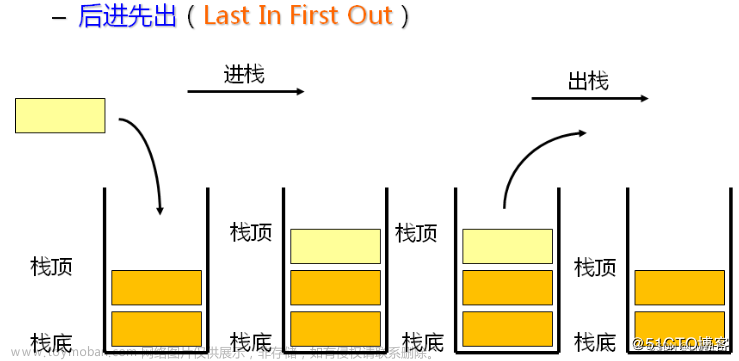💓博主个人主页:不是笨小孩👀
⏩专栏分类:数据结构与算法👀 刷题专栏👀 C语言👀
🚚代码仓库:笨小孩的代码库👀
⏩社区:不是笨小孩👀
🌹欢迎大家三连关注,一起学习,一起进步!!💓

用队列实现栈

队列是先进先出,而栈是先进后出,那我们怎么用两个队列来实现一个栈呢?
我们想要出数据的话,由于要实现的是栈,所以要后进先出,所以我们需要出4,但是由于他是队列,只能出1,但是我们有两个队列,我们假设队列一中有size个数据,那我们只需要将size-1个都放到另一个队列里面,然后在出掉最后一个就可以了。

如果需要入数据的话,我们就在不为空的那个队列后面入数据。
大概思想知道以后,我们就可以上手写代码了。(由于C语言没有队列,所以我们需要先拷贝一份我们之前写好的队列)
typedef int QDataType;
typedef struct QNode
{
QDataType date;
struct QNode* next;
}QNode;
typedef struct Queue
{
QNode* head;
QNode* tail;
int size;
}Queue;
//初始化队列
void QueueInit(Queue* pq);
//入队列
void QueuePush(Queue* pq, QDataType x);
//出队列
void QueuePop(Queue* pq);
//获取队头的元素
QDataType QueueFront(Queue* pq);
//获取队头尾的元素
QDataType QueueBack(Queue* pq);
//获取队列中有效数据的个数
int QueueSize(Queue* pq);
//判断队列是否为空
bool QueueEmpty(Queue* pq);
//销毁队列
void QueuDestroy(Queue* pq);
//初始化队列
void QueueInit(Queue* pq)
{
assert(pq);
pq->head = NULL;
pq->tail = NULL;
pq->size = 0;
}
//入队列
void QueuePush(Queue* pq, QDataType x)
{
assert(pq);
QNode* newnode = (QNode*)malloc(sizeof(QNode));
if (newnode == NULL)
{
perror("malloc fail");
exit(-1);
}
newnode->date = x;
newnode->next = NULL;
if (pq->head == NULL)
{
pq->head = pq->tail = newnode;
}
else
{
pq->tail->next = newnode;
pq->tail = newnode;
}
pq->size++;
}
//出队列
void QueuePop(Queue* pq)
{
assert(pq);
assert(pq->head);
if (pq->head->next == NULL)
{
free(pq->head);
pq->head = pq->tail = NULL;
}
else
{
QNode* next = pq->head->next;
free(pq->head);
pq->head = next;
}
pq->size--;
}
//获取队头的元素
QDataType QueueFront(Queue* pq)
{
assert(pq);
assert(pq->head);
return pq->head->date;
}
//获取队头尾的元素
QDataType QueueBack(Queue* pq)
{
assert(pq);
assert(pq->head);
return pq->tail->date;
}
//获取队列中有效数据的个数
int QueueSize(Queue* pq)
{
assert(pq);
return pq->size;
}
//判断队列是否为空
bool QueueEmpty(Queue* pq)
{
assert(pq);
return pq->size == 0;
}
//销毁队列
void QueuDestroy(Queue* pq)
{
assert(pq);
QNode* cur = pq->head;
while (cur)
{
QNode* next = cur->next;
free(cur);
cur = next;
}
pq->head = pq->tail = NULL;
}
//上面是我们自己的队列
//
typedef struct {
Queue q1;
Queue q2;
} MyStack;
MyStack* myStackCreate()
{
MyStack* obj = (MyStack*)malloc(sizeof(MyStack));
QueueInit(&obj->q1);
QueueInit(&obj->q2);
return obj;
}
void myStackPush(MyStack* obj, int x)
{
//Push到不为空的队列中
if(!QueueEmpty(&obj->q1))
{
QueuePush(&obj->q1,x);
}
else
{
QueuePush(&obj->q2,x);
}
}
int myStackPop(MyStack* obj)
{
//假设q1不为空
Queue* noEmpty = &obj->q1;
Queue* Empty = &obj->q2;
//如果假设错误,修改
if(QueueEmpty(&obj->q1))
{
noEmpty = &obj->q2;
Empty = &obj->q1;
}
//到数据
int x = QueueFront(noEmpty);
while(noEmpty->size>1)
{
QueuePush(Empty,x);
QueuePop(noEmpty);
x = QueueFront(noEmpty);
}
//此时x就保存了最后一个数据,pop掉,返回就可以
QueuePop(noEmpty);
return x;
}
int myStackTop(MyStack* obj)
{
//返回不为空的队列的尾
if(QueueEmpty(&obj->q1))
{
return QueueBack(&obj->q2);
}
else
{
return QueueBack(&obj->q1);
}
}
bool myStackEmpty(MyStack* obj)
{
//两个队列都为空,栈才为空
return QueueEmpty(&obj->q1)&&QueueEmpty(&obj->q2);
}
void myStackFree(MyStack* obj)
{
QueuDestroy(&obj->q1);
QueuDestroy(&obj->q2);
free(obj);
}
本题逻辑比较简单,但是结构很强,需要好好理解消化。
用栈实现队列

这个题和第一个题很相似,是用两个栈实现一个队列。
那这又怎么操作呢?
我们同样push数据时,如果两个都为空的话都可以push,但是如果出数据的话,由于需要先进先出,所以需要将不为空的那个栈的数据放到另一个栈中。

接下来另一个栈的数据是不是就满足我们需要的顺序了,正好1先进的1先出,接着是2,3,4,那如果没出的话接着push数据呢,我们只需要将数据还push到原来的呢个栈,这是我们不难发现只要当第二个栈的数据出完之后,然后将原本那个栈的数据倒过来就可以了。这个个队列不一样的是,不用每次都倒数据,我们可以将第一个栈叫push栈,第二个栈叫pop栈,然后当pop栈为空时,就将数据倒过来,接着出就可以了,如果两个栈都空了,那说明我们的队列就空了。
代码如下;
typedef int STDateType;
typedef struct Stack
{
STDateType* arr;
int top;
int capacity;
}Stack;
// 初始化栈
void StackInit(Stack* ps);
// 入栈
void StackPush(Stack* ps, STDateType x);
// 出栈
void StackPop(Stack* ps);
// 获取栈顶元素
STDateType StackTop(Stack* ps);
// 获取栈中有效元素个数
int StackSize(Stack* ps);
// 检测栈是否为空,如果为空返回非零结果,如果不为空返回0
bool StackEmpty(Stack* ps);
// 销毁栈
void StackDestroy(Stack* ps);
// 初始化栈
void StackInit(Stack* ps)
{
assert(ps);
ps->arr = NULL;
ps->capacity = 0;
ps->top = 0;
}
// 入栈
void StackPush(Stack* ps, STDateType x)
{
assert(ps);
if (ps->top == ps->capacity)
{
int newcapacity = ps->capacity == 0 ? 4 : ps->capacity * 2;
STDateType* pa = (STDateType*)realloc(ps->arr, newcapacity * sizeof(STDateType));
if (ps == NULL)
{
perror("realloc fail");
exit(-1);
}
ps->arr = pa;
ps->capacity = newcapacity;
}
ps->arr[ps->top] = x;
ps->top++;
}
// 出栈
void StackPop(Stack* ps)
{
assert(ps);
assert(ps ->top > 0);
ps->top--;
}
// 获取栈顶元素
STDateType StackTop(Stack* ps)
{
assert(ps);
return ps->arr[ps->top - 1];
}
// 获取栈中有效元素个数
int StackSize(Stack* ps)
{
assert(ps);
return ps->top;
}
// 检测栈是否为空
bool StackEmpty(Stack* ps)
{
assert(ps);
return ps->top == 0 ? true : false;
}
// 销毁栈
void StackDestroy(Stack* ps)
{
assert(ps);
free(ps->arr);
ps->arr = NULL;
ps->capacity = 0;
ps->top = 0;
}
//我们自己的栈
/
typedef struct
{
Stack Stackpush;
Stack Stackpop;
} MyQueue;
MyQueue* myQueueCreate()
{
MyQueue* obj= (MyQueue*)malloc(sizeof(MyQueue));
StackInit(&obj->Stackpush);
StackInit(&obj->Stackpop);
return obj;
}
void myQueuePush(MyQueue* obj, int x)
{
StackPush(&obj->Stackpush,x);
}
int myQueuePeek(MyQueue* obj)
{
//如果Pop栈为空就倒数据
if(StackEmpty(&obj->Stackpop))
{
while(!StackEmpty(&obj->Stackpush))
{
StackPush(&obj->Stackpop,StackTop(&obj->Stackpush));
StackPop(&obj->Stackpush);
}
}
return StackTop(&obj->Stackpop);
}
int myQueuePop(MyQueue* obj)
{
//调用返回队头的元素,并且判断了Pop栈是否为空
int x = myQueuePeek(obj);
StackPop(&obj->Stackpop);
return x;
}
bool myQueueEmpty(MyQueue* obj) {
return StackEmpty(&obj->Stackpop)&&StackEmpty(&obj->Stackpush);
}
void myQueueFree(MyQueue* obj)
{
StackDestroy(&obj->Stackpop);
StackDestroy(&obj->Stackpush);
free(obj);
}
这两个题逻辑非常简单,但是都对我们对结构的了解有很大的挑战。
设计循环队列

循环队列我们也可以用数组实现,也可以用链表实现,但是使用链表我们构造链表也是一件很麻烦的事情,而且当队列满时和队列空时情况一样,我们会很难区分,但是用链表也是可以实现的,但是我们这里介绍用数组实现。
我们这里需要K个空间,但是我们多开一个空间不存储数据,方便我们来区别空和满的情况。

我们可以看到空队列时front是和rear相等的。

当满队列时rear+1就等于front了。
设计这个循环队列,当rear超过K+1是我们就要让他回到0出,我们可以用if判断,也可以用取模操作。我们入数据就在rear位置入,出数据只需要将front++就可以了但是front也可能会越界。所以也需要取模操作。

这种情况front就可能越界,所以在写代码是要控制好边界。
代码如下:文章来源:https://www.toymoban.com/news/detail-674049.html
typedef struct
{
int* a;
int front;
int rear;
int k;
} MyCircularQueue;
MyCircularQueue* myCircularQueueCreate(int k)
{
MyCircularQueue* Mq = ( MyCircularQueue*)malloc(sizeof(MyCircularQueue));
Mq->a = (int*)malloc(sizeof(int)*(k+1));
Mq->front = 0;
Mq->rear = 0;
Mq->k = k;
return Mq;
}
bool myCircularQueueIsEmpty(MyCircularQueue* obj)
{
return obj->front==obj->rear;
}
bool myCircularQueueIsFull(MyCircularQueue* obj)
{
return (obj->rear+1)%(obj->k+1)==obj->front;
}
bool myCircularQueueEnQueue(MyCircularQueue* obj, int value)
{
if(myCircularQueueIsFull(obj))
{
return false;
}
obj->a[obj->rear] = value;
obj->rear++;
obj->rear = obj->rear%(obj->k+1);
return true;
}
bool myCircularQueueDeQueue(MyCircularQueue* obj) {
if(myCircularQueueIsEmpty(obj))
{
return false;
}
obj->front++;
//防止front越界
obj->front = obj->front%(obj->k+1);
return true;
}
int myCircularQueueFront(MyCircularQueue* obj) {
if(myCircularQueueIsEmpty(obj))
{
return -1;
}
return obj->a[obj->front];
}
int myCircularQueueRear(MyCircularQueue* obj) {
if(myCircularQueueIsEmpty(obj))
{
return -1;
}
//obj->read==0的话应该是返回k那个位置的
return obj->rear==0?obj->a[obj->k]:obj->a[obj->rear-1];
}
void myCircularQueueFree(MyCircularQueue* obj) {
free(obj->a);
free(obj);
}
今天的分享就到这里结束了,感谢大家的关注和支持。文章来源地址https://www.toymoban.com/news/detail-674049.html
到了这里,关于栈和队列OJ题讲解的文章就介绍完了。如果您还想了解更多内容,请在右上角搜索TOY模板网以前的文章或继续浏览下面的相关文章,希望大家以后多多支持TOY模板网!














